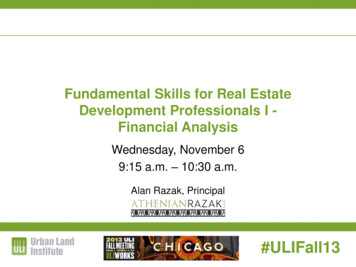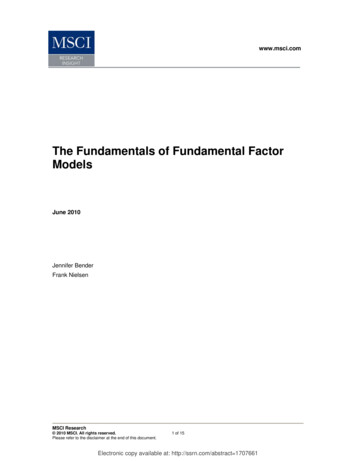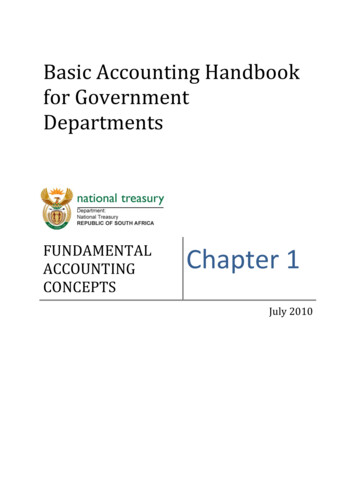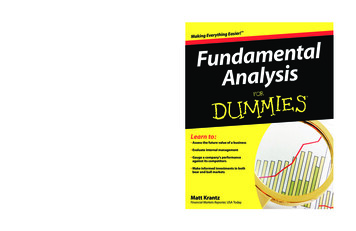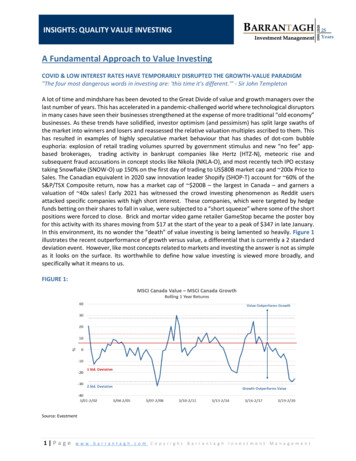
Transcription
INSIGHTS: QUALITY VALUE INVESTINGA Fundamental Approach to Value InvestingCOVID & LOW INTEREST RATES HAVE TEMPORARILY DISRUPTED THE GROWTH-VALUE PARADIGM"The four most dangerous words in investing are: 'this time it's different.'" - Sir John TempletonA lot of time and mindshare has been devoted to the Great Divide of value and growth managers over thelast number of years. This has accelerated in a pandemic-challenged world where technological disruptorsin many cases have seen their businesses strengthened at the expense of more traditional “old economy”businesses. As these trends have solidified, investor optimism (and pessimism) has split large swaths ofthe market into winners and losers and reassessed the relative valuation multiples ascribed to them. Thishas resulted in examples of highly speculative market behaviour that has shades of dot-com bubbleeuphoria: explosion of retail trading volumes spurred by government stimulus and new “no fee” appbased brokerages, trading activity in bankrupt companies like Hertz (HTZ-N), meteoric rise andsubsequent fraud accusations in concept stocks like Nikola (NKLA-O), and most recently tech IPO ecstasytaking Snowflake (SNOW-O) up 150% on the first day of trading to US 80B market cap and 200x Price toSales. The Canadian equivalent in 2020 saw innovation leader Shopify (SHOP-T) account for 60% of theS&P/TSX Composite return, now has a market cap of 200B – the largest in Canada – and garners avaluation of 40x sales! Early 2021 has witnessed the crowd investing phenomenon as Reddit usersattacked specific companies with high short interest. These companies, which were targeted by hedgefunds betting on their shares to fall in value, were subjected to a “short squeeze” where some of the shortpositions were forced to close. Brick and mortar video game retailer GameStop became the poster boyfor this activity with its shares moving from 17 at the start of the year to a peak of 347 in late January.In this environment, its no wonder the “death” of value investing is being lamented so heavily. Figure 1illustrates the recent outperformance of growth versus value, a differential that is currently a 2 standarddeviation event. However, like most concepts related to markets and investing the answer is not as simpleas it looks on the surface. Its worthwhile to define how value investing is viewed more broadly, andspecifically what it means to us.FIGURE 1:Source: Evestment1 Pagewww.barrantagh.com Copyright Barrantagh Investment Management
INSIGHTS: QUALITY VALUE INVESTINGTRADITIONAL VIEW OF VALUE INVESTING“Buy cheap and sell dear.” - Benjamin GrahamFor much of what is considered the core tenets of a value investing philosophy we have Benjamin Grahamto thank. Concepts like margin of safety, determining an intrinsic value based on the facts, marketsentiment versus speculation and many others have been eloquently laid out in Security Analysis (withDavid Dodd) and later The Intelligent Investor for over 75 years. Though many of Graham’s insights remainas relevant today as ever, some have chosen to focus more on the specific applications laid out in thesetexts, like searching for “net-nets” (shares trading lower than net current asset value per share) orabsolute levels of low price to book value (P/B), or low price to current earnings (P/E) as the way todemonstrate value discipline. Though not entirely what Graham espoused, the “cigar butt” investing style(an allegory that suggests a cigar butt left on the side of the road still has one good puff left in it) thatdecouples low price from any consideration to the quality of the company or the durability of theirearnings has nevertheless been linked with him. Thus has followed the traditional view of value investing,buying stocks that are cheap on price to book value or price to earnings – and this is still the sole waymany of the value benchmarks are compiled or stratifications take place. Like most things that getsystematised, it becomes a shortcut (it is human nature to do the least work possible) and in our viewresults in a sub-optimal classification as it underrepresents many key investment considerations. Theinvestment universe today does not look the same as in the 1950’s: accounting conventions have changed,interest rates have changed, North American economies are much more service based, and internallygenerated intangibles that are so dominant in the knowledge-based economy are not recognized on anybalance sheet. If the historical view and stratification is too narrow, how do we demonstrate a valuediscipline?OUR QUALITY-VALUE APPROACH“All intelligent investing is value investing – acquiring more than you are paying for. You must value thebusiness in order to value the stock.” - Charlie MungerAs a value manager, we have performed very well for our clients despite the bias to growth strategies.This is because at Barrantagh we have always approached our value investing in a broader sense than aone-dimensional historical view focused solely on current valuation parameters. We embrace the maxim“cash is king” by focusing on detailed, bottom-up cashflow forecasts which is the methodology used bybusinesses during merger and acquisition activity. We employ discounted cashflow methodology (DCF)to determine the intrinsic value of a business effectively discounting future cashflows to their presentvalue. This approach involves working with forward growth estimates to forecast future cashflows and inthe opposite direction an assessment of appropriate discount rates to convert these forecasts to a presentday value price. We understand the fundamental dilemma that the most important factor for an equityinvestment is the future, but the future is inherently uncertain. Our overall assessment of a companywithin the framework in Figure 2 help guide our determination of appropriate growth rates to use in ourforward estimates. Profitable companies with competitive advantages, low economic cyclicality, seculartailwinds, strong management, conservative leverage and good ESG (environment, social, governance)scores all contribute to our conviction surrounding an uncertain future and the determination of abusiness’ overall QUALITY. The second part of the DCF analysis requires our estimate of an appropriatediscount rate. Of particular importance is adding a company or industry risk premium to reflect potentialinstability in a company’s cost of capital which may be attributable to a variety of reasons (high cyclicality,small company premium, leveraged balance sheet). Thus, to develop a level of comfort or conviction on apotential investment we use a conservative bias in our estimates for growth and discount rates andrequire a minimum return potential from the current market price. This margin of safety reflects VALUE.2 Pagewww.barrantagh.com Copyright Barrantagh Investment Management
INSIGHTS: QUALITY VALUE INVESTINGTo do this, deep analysis of a business’ fundamentals is paramount.FIGURE 2:Fundamental analysis in the quest for quality allows us to avoid the risks of potential “value traps” if onesimply dumbs valuation down to a current multiple. Our approach provides the ability for more nuancedunderstanding of a business’ worth based on fulsome financial analysis and probability-weightedforecasts. This may identify investment opportunities in market sectors, sub-sectors, or stocks themselvesthat do not fit neatly under a traditional Graham-Dodd “value” screen. If we are doing things right, wegain exposure to companies with higher probabilities that things will improve for them – and effectivelyexploit the QUALITY VALUE opportunity.WHAT IT LOOKS LIKE WHEN IT WORKS – COMPOUNDERS“Time is the friend of the wonderful business, the enemy of the mediocre.” - Warren BuffettNotwithstanding, the nuanced discussion of what “value” may mean to an individual investor, we believeone market observation has stayed consistent over time: people want to own good businesses and thosebusinesses will generally garner a lower cost of capital. There is, however, ambiguity in what constitutes“good” and depending on shifting sentiment different metrics get weighed with different levels ofattention or neglect. Presently there are quality businesses being undervalued and quality businessesbeing overvalued, with the proforma investment returns scaling accordingly. This can happen for a hostof reasons that mostly boil down to either a myopic focus on the short-term or emotionaloverreaction/underreaction to events, which can create mismatches in the market between the strengthof a business’ cash flow stream and how it is being valued. This is the opportunity we seek – mispriced risk– and when encountered the rewards can be substantial. Either the Company delivers results more thanmarket expectations, the market wises up to the quality of the business and affords it a higher multiple,or oftentimes both. This is the crux of Jim Grant’s observation that “successful investing is having everyoneelse agree with you later.” The opposite also holds true – the business is great but stratosphericexpectations on growth and valuation can implode under its own weight. There are thus two key partswhen breaking down the DNA of a “compounder” – it is not just the growth but the entry point! If yourforecasts turn out to be wrong your margin of safety protects/minimizes against permanent loss of capital.If you are early and right, exponential returns can result. To demonstrate this concept, it is perhapsinstructive to look at a couple of successful examples.3 Pagewww.barrantagh.com Copyright Barrantagh Investment Management
INSIGHTS: QUALITY VALUE INVESTINGCargojetWe initiated a position in Cargojet (CJT) in 2010 at a stock price of 9.74. We felt the Company had a goodchance of ultimately winning the transformational contract with Canada Post group of companies (CPOG)which they subsequently were awarded in February 2014. Over the years the following key events havedriven our internal expectation of fair value on the shares higher. These events collectively solidifyCargojet’s leadership position and enhance the quality assessment of the firm. Our internal valuationwork led to multiple upgrades in the CJT price target which reconfirms the value in the company’s shares.Currently the stock trades at 180 and our 250 target (DCF) implies continued upside. Notable eventsover this time horizon: Winning CPOG contract (2014)Fleet build out and getting to profitability (2014-2015)Operating leverage driving increased cash flows (2016)Initial wave of e-commerce growth (2016 – 2018)Expansion of Charter/ACMI driving higher fleet utilization and returns (2016-2020)Strategic agreement with Amazon (2019)COVID pandemic accelerating e-commerce (2020)COVID pandemic significantly curtailing passenger belly cargo capacity (2020)Large fleet expansion plans to meet growing demand, including new 777 conversions (2021)Figure 3 below illustrates CJT’s share price appreciation since the initial purchase. Since that time, wehave taken profit by trimming the position 10 times. Admittedly it may appear that the best course ofaction would have been not to sell any of the shares. However, prudent portfolio management typicallylimits single stock exposures to less than 8% of a portfolio which is another margin of safety for clients.FIGURE 3Source: Bloomberg4 Pagewww.barrantagh.com Copyright Barrantagh Investment Management
INSIGHTS: QUALITY VALUE INVESTINGTrisura GroupA more recent example, Trisura (TSU), was added in Q4 2019 at a stock price of 40. Our initial analysisoutlined an attractive risk/reward opportunity for this steady core Canadian business with a history ofprofitable underwriting. Trisura’s management team is highly capable with an ‘under-promise and overdeliver’ mentality. The stock has an attractive valuation in the context of ‘low hanging’ growth and largercap peers. They are experiencing early success in new U.S. business with a differentiated tech-enabledand nimble offering. They have effectively immunized their interest rate exposure from their Internationalreinsurance business where they were exposed to interest rate risk, effectively removing historicalearnings headwinds. With the scarcity of quality-value small cap financials, we expect Trisura’s profile togrow significantly.As Trisura delivers on their strategic plan, we note the following has taken place: Trailing Return on Equity from 2% to 13%; trailing Earnings Per Share growth 9x; forwardearnings expectations up 100% U.S. gross premiums increased from 70 million per quarter to 210 million, more than triplingthe fronting fee income Market capitalization increased by 4x with an 10x increase in trading liquidity Total shareholder return 215%On a go-forward basis, our forecast for this stock remains very positive. We anticipate continued strongunderwriting and stable execution in Canada. We see further growth from their large U.S. opportunitygiven they’re still growing off a relatively small base. Entrance into the Admitted market grows the totalavailable market 5x. We anticipate multiple expansion as the capital-light, fee-based fronting incomegrows in significance. With a 5-year growth in earnings of 15% annually, the share price target wouldbe 225- 250. Accretive M&A and/or a potential takeout could further accelerate shareholder returns.Though these observations represent our current constructive view, we monitor closely for any newinformation that will impact our expectations, either positively or negatively. Figure 4 below illustratesTSU’s share price appreciation since the initial purchase in Dec 2019.FIGURE 4Source: Bloomberg5 Pagewww.barrantagh.com Copyright Barrantagh Investment Management
INSIGHTS: QUALITY VALUE INVESTINGSIMPLE, NOT EASY“Don’t explain your philosophy. Embody it.”- EpictetusHere at Barrantagh we let our “Quality-Value” framework drive everything we do. Looking at CJT or TSUon a superficial level would indica
INSIGHTS: QUALITY VALUE INVESTING A Fundamental Approach to Value Investing COVID & LOW INTEREST RATES HAVE TEMPORARILY DISRUPTED THE GROWTH-VALUE PARADIGM "The four most dangerous words in investing are: 'this time it's different.'" - Sir John Templeton A lot of time and mindshare has been devoted to the Great Divide of value and growth managers over the last





